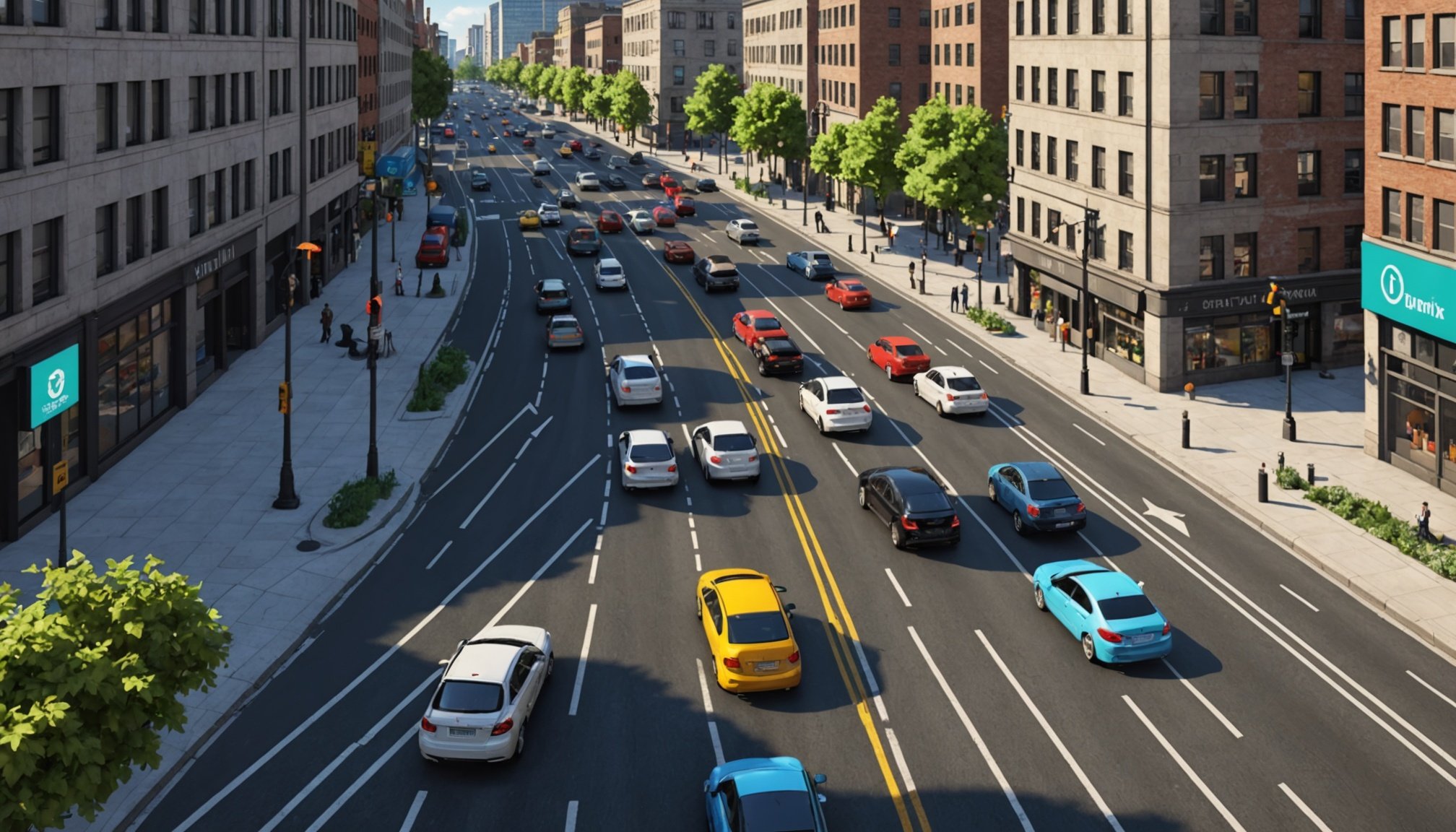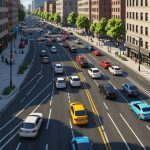Understanding Traffic Generation in Urban Simulation Games
Traffic generation is a critical component of urban simulation games, playing a pivotal role in shaping the gameplay experience. It acts as a fundamental mechanic that mimics real-world urban dynamics, enhancing realism and complexity in the virtual cityscape. Understanding how traffic generation works is essential for players aiming to design efficient and thriving environments.
Urban simulation mechanics rely on algorithms to simulate traffic patterns, taking into account factors like road capacity, vehicle speed, and traffic signal timings. These mechanics influence traffic behavior, dictating how smoothly or congestedly the traffic flows through the city. Players often engage in traffic simulation analysis to optimize these parameters and improve in-game outcomes.
Also to see : Unveiling the challenges of voice-controlled interfaces in strategy games: a deep dive into integration obstacles
Effective management of traffic generation can significantly alter the gameplay experience. For example, players must strategically plan road layouts and public transport systems to reduce congestion, thereby increasing the city’s overall productivity and citizen satisfaction. Players skilled in traffic simulation analysis can manipulate these mechanics to build cities that reflect their vision of urban utopia, keeping the virtual residents happy and the economy booming. This intricacy not only challenges but also encourages players to delve deeper into the game’s strategic aspects, ensuring an enriching experience.
Proven Strategies for Authentic Traffic Scenarios
Creating realistic urban simulations necessitates using effective strategies. Authentic traffic simulation can enhance user engagement by replicating real-world dynamics.
Utilizing Real-World Data for Better Simulation
Integrating Geographic Information System (GIS) data is essential for simulating realistic traffic strategies. By incorporating GIS, simulations can mirror actual urban landscapes, providing a more authentic experience. Leveraging data on real traffic patterns and congestion is another pivotal aspect. It involves using historical and current traffic records to mimic genuine traffic flows. For instance, analyzing peak hour congestion data can help predict and replicate similar conditions within the simulation.
Implementing Dynamic Traffic Systems
Dynamic traffic systems adapt to changing conditions, unlike static models. Essential tools and software like VISSIM or Aimsun facilitate dynamic traffic modeling, offering a robust framework for real-time simulation. These systems provide significant benefits in gameplay by enhancing realism, allowing players to interact with evolving traffic situations.
Designing Intersections and Road Networks for Reality
Intersection design is crucial for influencing traffic flow. Key principles include appropriate signal timing and lane design, which directly affect congestion levels. Various road network layouts, such as grid patterns or radial designs, also have specific realism implications. Examples from popular games, like SimCity, illustrate how varied designs impact traffic simulation, providing players with a more convincing and engaging experience.
Enhancing Player Experience Through Traffic Management
In strategy and simulation games, traffic management strategies can significantly impact the user experience. Realistic traffic behavior often enhances player immersion, drawing them deeper into the game world. When traffic responds dynamically, reflecting real-world scenarios, it can transform generic gameplay into a vivid, engaging experience.
Tweaking traffic settings is essential for gamers seeking optimal gameplay enhancement. Adjust these settings to balance between realism and playability. For instance, adjusting traffic flow to match peak and off-peak times can offer a realistic challenge without overwhelming players. Experiment with vehicle spawn rates and route optimization to keep frustration at bay while maximizing engagement.
Community insights provide valuable tips on refining traffic settings. Many experienced players suggest using mods or custom scripts to fine-tune traffic behavior, enhancing the core gaming framework. Feedback from community forums often highlights innovative approaches, such as using traffic management tools to alleviate congestion or employing strategic zoning to guide traffic flow efficiently.
By continuously refining traffic management, players can significantly enhance their gaming experience, ensuring it remains both challenging and captivating. This balance often differentiates a good game from a truly memorable one, where traffic nuances contribute to a more immersive environment.
Case Studies of Successful Traffic Simulation Implementation
In recent years, traffic simulation case studies have provided insightful glimpses into urban dynamics, particularly through the lens of urban simulation examples in gaming. These studies have highlighted the potential and challenges associated with accurately simulating city ecosystems.
Notable Games with Superior Traffic Mechanics
Among these, games such as “Cities: Skylines” stand out for their acclaimed traffic systems. The game excels in integrating complex traffic mechanics, allowing players to experience realistic city management. The combination of detailed road networks, public transportation options, and traffic flow analytics creates a rich, engaging simulation. Players appreciate the balance between challenge and reward, often praising the game for its effective handling of congestion and urban planning.
Comparative Analysis of Approaches to Traffic Generation
By examining different traffic generation strategies across various games, one observes distinct methodologies. Some games, like “SimCity”, employ a rule-based system, prioritising accessibility and user control. Others, such as “Factorio”, focus on logistics, promoting efficiency and network optimisation. Each approach has its benefits: rule-based systems offer intuitive gameplay while logistics-focused models improve realism. For developers, understanding these differences is crucial in crafting experiences that both entertain and educate. Ultimately, the ideal simulation combines innovation, precision, and player feedback to enhance the game analysis and achieve success in traffic realism.
Visual Aids and Community Resources for Traffic Simulation
Visual aids are essential tools for understanding the complexities of traffic systems. They transform abstract data into clear, actionable insights. Whether dealing with real-world scenarios or virtual environments, visual aids make it easier to identify traffic patterns and solutions. Various urban simulation games, such as SimCity, offer excellent visual examples that illustrate complex traffic dynamics in a user-friendly manner. These games serve as educational platforms, enabling enthusiasts to experiment with traffic systems under different scenarios.
For those interested in diving deeper, there are numerous community forums and resources that traffic simulation enthusiasts can benefit from. These online environments provide a wealth of community insights. They are spaces where users can share experiences, exchange tips, and propose solutions. Websites like Reddit’s Urban Planning subreddit and specialized traffic simulation forums serve as excellent community resources. Such platforms facilitate the exchange of knowledge and promote a deeper understanding of urban traffic behavior.
Additionally, urban gaming resources help bridge the gap between theoretical models and practical applications. By leveraging these resources, users can gain hands-on experience, enhancing their ability to analyse and improve traffic systems, ultimately contributing to more efficient urban environments.











